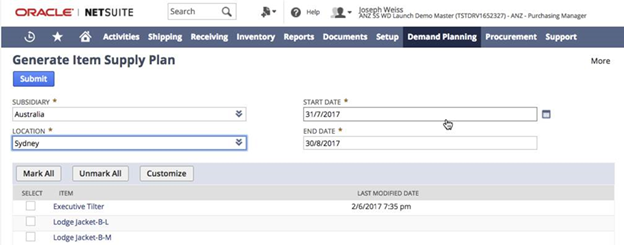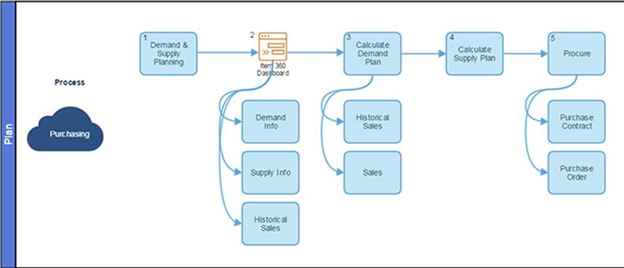Balancing supply and demand in your manufacturing or distribution business is a delicate process. Both an art and a science, good supply planning ensures that your business has the right combination of cost control, lead times and service level.
Supply planning and demand planning go arm in arm in the manufacturing and distribution industry. Supply planning is part of supply chain management and helps determine how to best fulfill the requirements outlined in your demand plan.
It’s nearly impossible to execute proper supply planning without having a strong technology tool at your side.
NetSuite uses advanced inventory management and demand planning techniques to help you make the right decisions and increase your on-time delivery metrics. Each location where you store inventory can be set up with unique parameters to deliver unprecedented control over your supply chain.
Overview of Item Supply Planning
In our blog post How Manufacturers and Distributors Can Master Demand Planning we looked at NetSuite’s powerful demand planning component. Let’s transition over to supply planning, represented by steps 4 and 5 in the diagram below:
NetSuite’s demand and supply planning flow
In a nutshell, your demand plan will provide supply order requirements. A supply plan details orders to be placed for items that are recommended based on:
- On hand quantity
- Lead time
- Safety stock level
- Projected demand
- Outstanding items
- Quantities in posting transactions such as receipts, fulfillments, cash sales and invoices
- Quantities in non-posting transactions such as purchase orders, sales orders, work orders and transfer orders
 Example of item supply plan in NetSuite
Example of item supply plan in NetSuite
After reviewing the demand quantity and quantity on hand in NetSuite’s gross requirements inquiry, you can use these supply requirements to drive your procurement supplier contracts and direct purchase orders.
Filtering options allow you to customize the view of the results by subsidiary and location. Users can view and/or edit order date, expected receipt date and quantities to be ordered.
Your supply plan focuses on purchase orders, assemblies, work orders, transfer orders and intercompany transfers. Inventory adjustments are excluded from the process since they are typically used during inventory count inconsistencies.
Any solid workflow initially requires setup. Configure these key fields on each item record:
- Multi-location inventory
- Default lead time is time elapsed between date of purchase and receipt based on an item’s purchase receipt lines per location
- Safety stock level is the default number of days you always want on hand (buffer amount)
- Preferred stock level is the number of days you want to maintain in inventory
- Default available to promise (ATP) methods
- Cumulative ATP with look ahead supplies estimates based on all outstanding orders within a horizon; this allows you to account for shortages that may occur in the future
- Discrete ATP reviews the amount available in each supply order and provides and available date for the given quantity
- ATP lead time
- Replenishment method
- Reorder point
- Time phased; only items set to this method use plans that look at:
- Outstanding CRM data, opportunities, estimates and sales orders
- Projection of historical demand mathematically
- Sales history of an alternative source item
- Lot sizing method (how your orders are suggested for procurement)
- Fixed lot size
- Lot for lot
- Periods of supply (weekly, monthly or interval)
Overview of Ordering Items
To continue the workflow, NetSuite’s order items step provides a list of items where the stock level is at or below the reorder point and suggests a quantity to order based on preferred stock level and quantity on open backorders.
After verifying and editing suggested amounts, you can generate and email the item’s purchase orders, one purchase order per vendor. The purchasing department’s steps are done!
Once vendor shipments are received, the warehouse will continue with the next step in workflow. Likewise, when the vendor invoice is received, it will be matched and become accounts payable.
Summary of Purchasing Department’s Workflow Steps
Here’s the workflow in the purchasing department:
- Calculate supply items (recommended orders)
- Order items (process purchase orders)
- Receive purchase orders into warehouse management system
- Match vendor invoice in accounts payable
Later, the purchasing manager can use the item demand forecast vs. actual report to analyze the performance of his or her team.
How NetSuite Makes the Lives of Supply Planners Easier
Let’s look more closely at what NetSuite offers supply planners.
Supply Plans and Order Executions
Supply plans can be generated by using the item settings from the demand plans with a simple click, reducing time consuming manual processes. Depending on some parameters and approval workflows, the system will either generate firm planned or released orders.
Planning Action Messages
NetSuite can also generate planning messages to assist the user in making the right decisions and optimize inventory levels where appropriate.
Gross Requirements Inquiry
The gross requirements inquiry provides an overview of the progressive supply and demand cycle by listing quantities required and quantities supplied on each transaction date listed. Each transaction and date is listed along with the more-on-hand or less-on-hand quantity of the transaction, as well as the resulting total quantity on hand for the item.
Order Execution
The result of the supply planning process simplifies the process of creating purchase orders, transfer orders and work orders for the user and they can be notified in a number of ways when they have to do something. This includes:
- Reminders
- Email alerts
- Saved searches
- Scheduled reports
Executing these from the order items or mass create work order screens is as simple as checking a box beside the orders you want to create, then hitting a button.
Allocation Exceptions Management
To respond to supply shortages and VIP customers, you can review all sources of supply and order allocations to ensure that high priority sales orders ship complete and on time. To minimize the effect on all orders, the system provides intelligent supply reallocations recommendations, designed to take the resources from multiple unallocated orders and fulfill priority orders first.
System generated reallocation recommendations reduce the time to find, review and execute reallocations. After you accept a recommendation, the system automatically re-aligns the supplies to the affected orders.
However, if the generated recommendations are not suitable, you can generate a new set of allocation recommendations. You can then review reallocation scenarios until you define a solution. After you approve an allocation, the system returns you to the order.
More On NetSuite’s Demand and Supply Planning
This video offers more insight into NetSuite’s demand and supply planning capabilities.
Need Help?
If you’d like to improve your order fill rates and fulfillment accuracy, contact us online or call 410.685.5512 to see a system like this in action.



